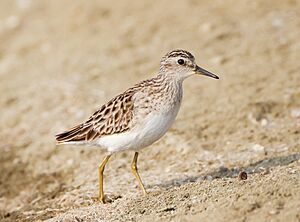Long-toed stint facts for kids
Quick facts for kids Long-toed stint |
|
|---|---|
 |
|
| Conservation status | |
| Scientific classification | |
| Synonyms | |
|
Erolia subminuta |
The long-toed stint (Calidris subminuta) is a small wader, a type of bird that often lives near water. Its name, Calidris, comes from an old Greek word for grey waterside birds. The second part, subminuta, means "near to small" in Latin. This is because it looks a bit like the little stint, which is another small bird.
This bird breeds in northern Asia. It is a strong migratory bird, meaning it travels long distances. It spends its winters in south and southeast Asia and Australasia. You might only see it in western Europe very rarely.
The long-toed stint has yellowish legs and a short, thin, dark beak. When it's breeding, its feathers are a rich brown on top with darker centers. Its belly is white. It has a light line above its eye and a brown head. In winter, these birds turn grey on their upper parts. Young long-toed stints have bright patterns on their backs with reddish colors and white stripes.
This bird can be tricky to tell apart from other tiny waders. These small birds are sometimes called "peeps" or "stints." The long-toed stint looks a lot like the least sandpiper from North America. However, the long-toed stint looks more slender and has a longer neck. It also has longer toes, brighter colors, and a less noticeable wing stripe.
These birds find their food on mudflats. They usually pick up food they see, but sometimes they also probe the mud with their beaks. They mostly eat small crustaceans, insects, and snails. We don't know much about how they raise their young. But we do know they build their nests on the ground. The male bird also performs a special flight to attract a mate.
Contents
What Does the Long-Toed Stint Look Like?
The long-toed stint is a very small bird. It is only about 13 to 16 centimeters (5 to 6 inches) long. Its wings can spread out about 26.5 to 30.5 centimeters (10 to 12 inches). It weighs around 25 grams (less than an ounce).
This bird has a small head and a short, straight, sharp beak. Its neck is thin, and its belly is rounded. Its long legs are set far back on its body. The toes are long and thin, especially the middle one. The main wing feathers reach all the way to its tail.
The top of its head is brown, and there is a light stripe just above its eye. Its upper body is brown, with the centers of the feathers being a darker brown. Its chest has light brown speckles, and its underside is white. The legs and feet are yellow. The beak is dark brown, but the bottom part near its face is yellow or light brown.
The long-toed stint has a unique way of standing. Its call during flight also helps tell it apart from other sandpipers. On the ground, it can be confused with the red-necked stint (Calidris ruficollis). But the long-toed stint is built more delicately and is a little smaller.
Where Do Long-Toed Stints Live?
The long-toed stint lays its eggs and raises its young in Siberia during the Northern Hemisphere summer. We don't know much about its breeding habits. But its breeding areas include the Chukchi Peninsula and the Koryak Plateau. It also breeds near the Commander Islands, the Kuril Islands, and the land next to the Sea of Okhotsk. Other breeding spots are north of the Verkhoyansky District and around the Ob River and the Irtysh River.
After the breeding season, these birds fly south. They travel through China, Indochina, Malaysia, and the Philippines. Some also fly west to Burma, Bangladesh, Nepal, Sri Lanka, and the Maldive Islands. They visit New Guinea and Australia. Sometimes, they are seen in places like Sweden, South Africa, Hawaii, and the northwestern USA. These are called "vagrants" because they are far from their usual path.
In winter, they live in many different wet places. These include shallow freshwater or salty areas, lakes, swamps, floodplains, marshes, and muddy shores. They can even be found near sewage ponds.
What Do Long-Toed Stints Do?
The long-toed stint looks for food in wet areas. It pokes its beak into the ground. It eats molluscs, crustaceans, small amphibians, insects, and other tiny creatures. It also eats seeds.
When it rests, it finds hollows in soft mud or hides in low plants near its feeding area. In Russia, where it breeds, it lives in tundra, taiga, open grassy bogs, or swamps. Its nest is usually a hidden, shallow dip. It is often found on a small mound of sedge (a grass-like plant) or dried grass.
How Many Long-Toed Stints Are There?
The long-toed stint lives across a very large area. Experts believe there are between 10,000 and 100,000 of these birds in the world. There might be around 25,000 pairs that breed each year.
We don't know if their numbers are going up or down. But the IUCN (International Union for Conservation of Nature) says the bird is of "least concern." This means they are not currently worried about it becoming endangered. No major threats to the long-toed stint have been found.


